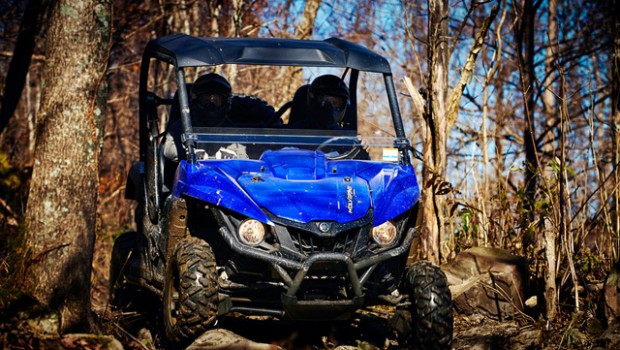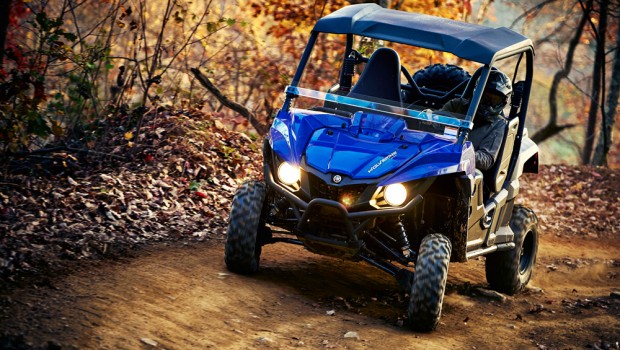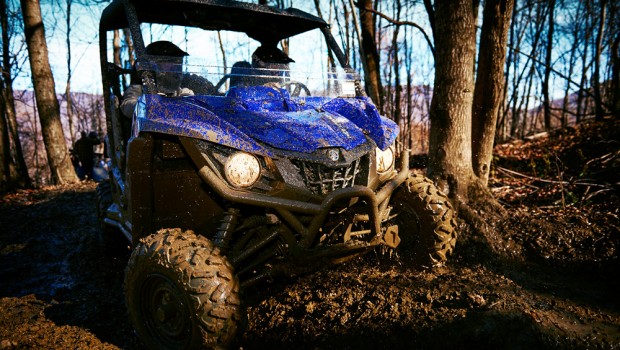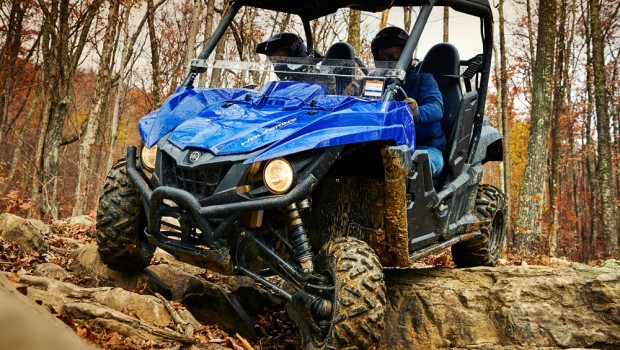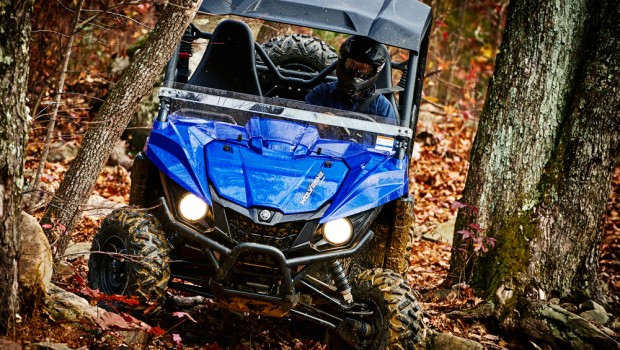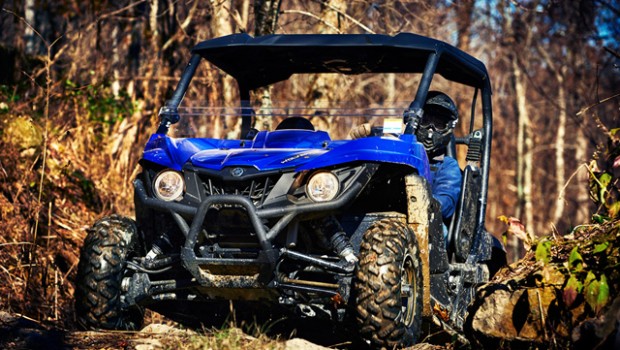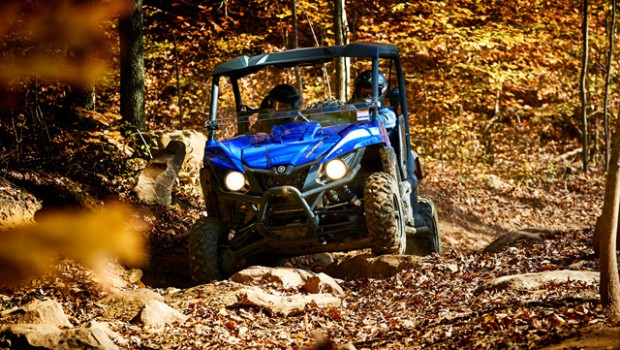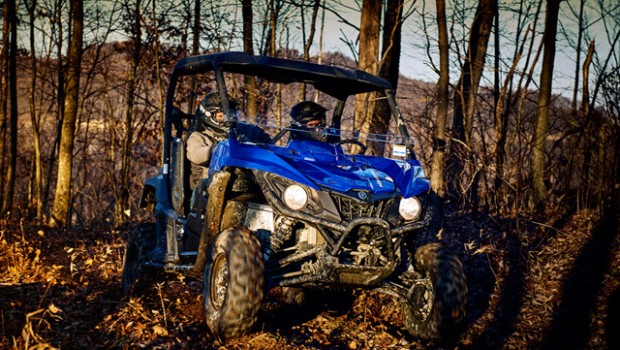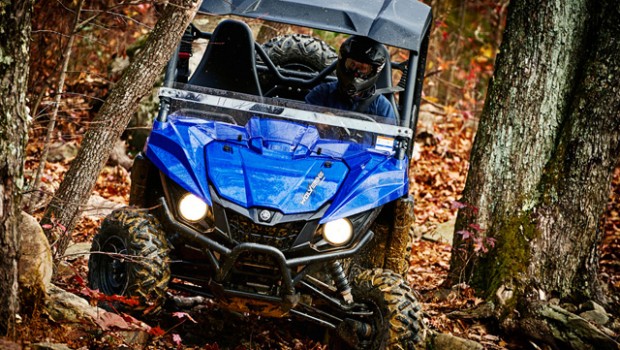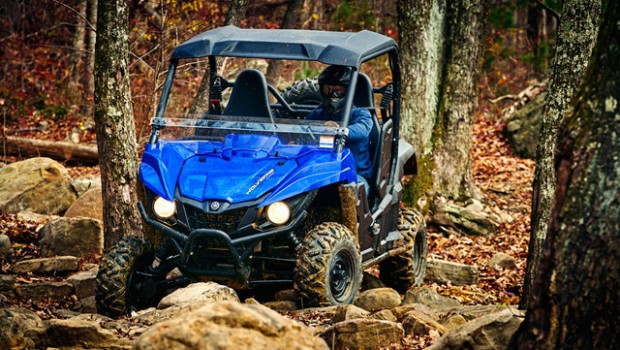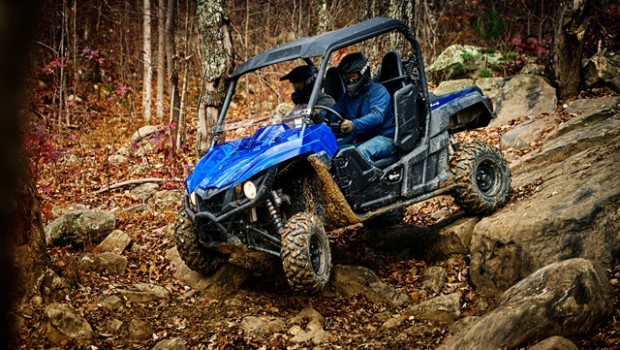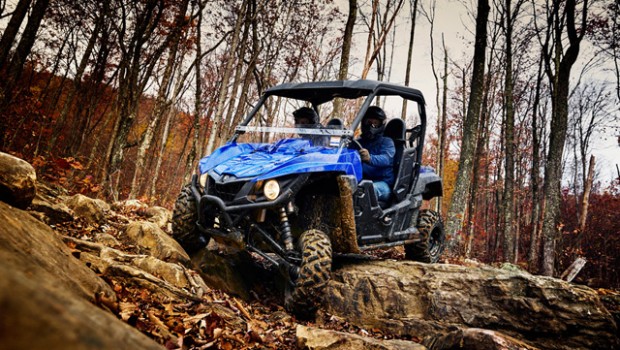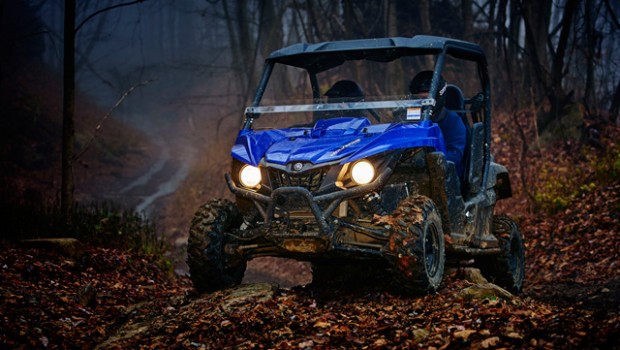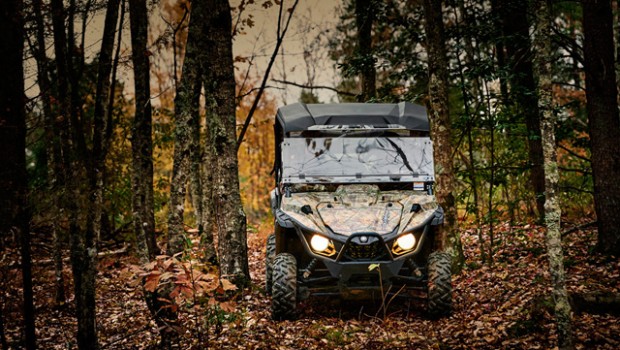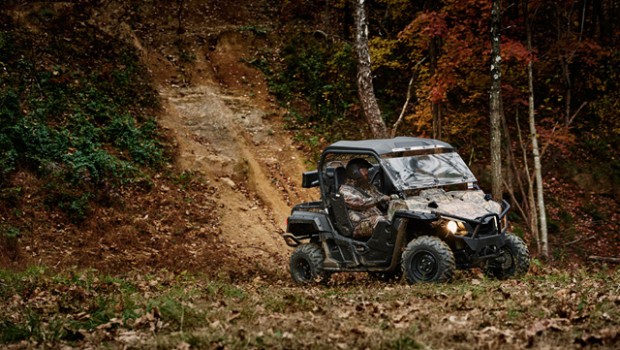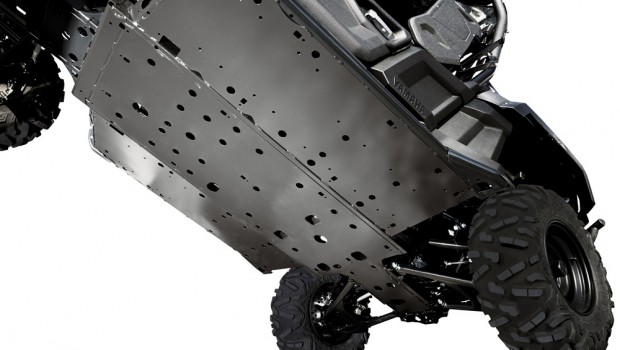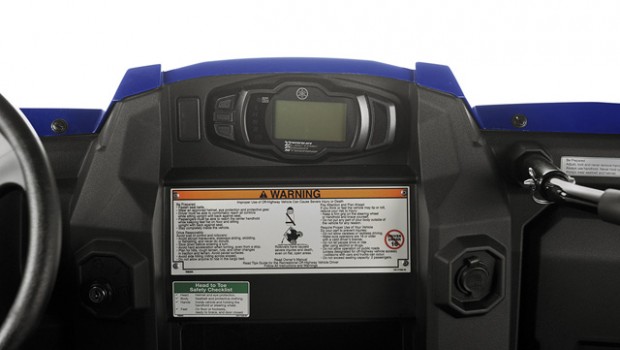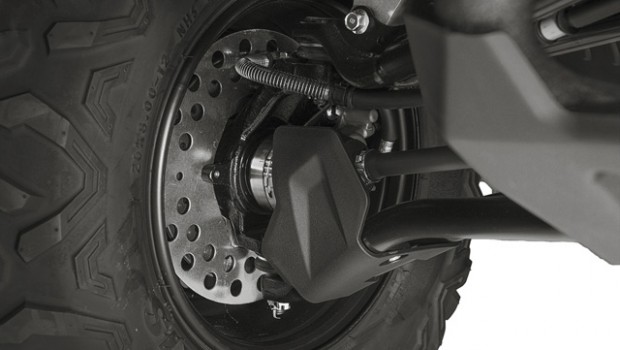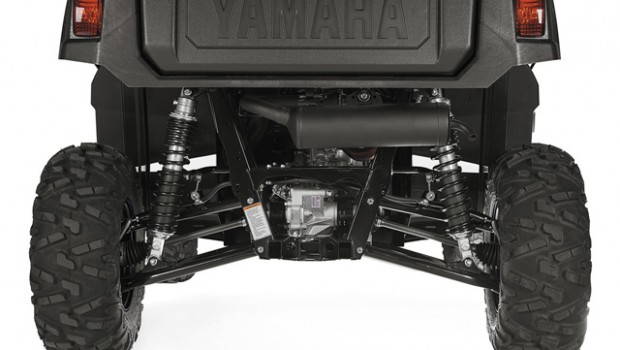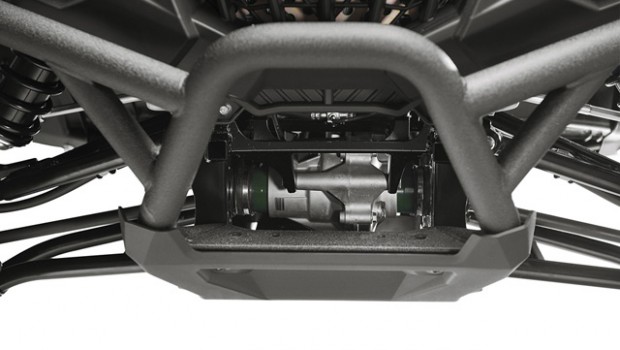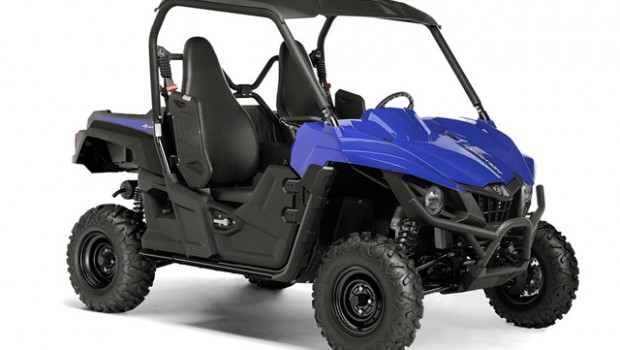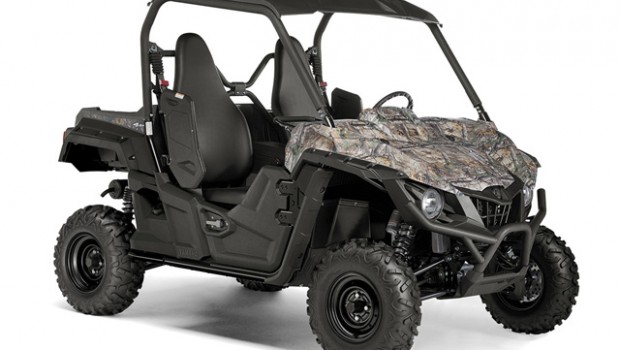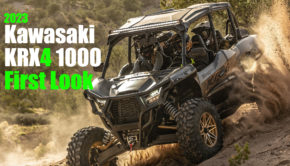2016 Yamaha Wolverine R-Spec Side-by-Side, First Look:
A look at Yamaha’s most sport-focused UTV to date!
In 2004 Yamaha created a new off-road craze with their Rhino 660. While not a pure sport machine, the Rhino was more of a sport utility machine offering a level of engine performance, nimble handling, and quality of suspension that outshined the purely utilitarian machines of the time. It immediately began attracting would-be ATV buyers looking to bring a friend along for the ride, and its instant sales success spawned a boom in aftermarket companies and high-performance accessory part development.
While Yamaha was dealing with the legalities of having solely created a new segment, the UTV world split into three distinctively different categories: Work Utility, Sport Utility, and Sport performance. With Yamaha having released the new Utility-focused Viking and Viking 6 models they turned their attention to recapturing the segment that they created 11 years ago, with the development and release of the brand new 2016 Yamaha Wolverine R-Spec.

With Yamaha having released the new Utility-focused Viking and Viking 6 models they turned their attention to recapturing the segment that they created 11 years ago, with the development and release of the brand new 2016 Yamaha Wolverine R-Spec.
The Wolverine Legacy
ATV enthusiasts may remember the Wolverine name from the Wolverine 350 4×4 launched in 1995. The name was later carried over to the Wolverine 450. These machines were designed for the ATV rider looking for a 4×4 machine focused more on exploring and having fun than work. With much the same aspirations as the retired Wolverine ATVs, the name seemed like the perfect fit for Yamaha’s new trail and sporting-focused UTV, the Wolverine R-Spec.
Newnan, Georgia Introduction
 Yamaha invited a small group of power sports and outdoor editors to their manufacturing plant in Newnan, Georgia for our first look at the new machine and the people responsible for all of the side-by-sides Yamaha sells worldwide. With the United States accounting for over 70 percent of the world’s total ATV sales, Yamaha completed a three-year production transfer in 2013, moving ATV production to the US.
Yamaha invited a small group of power sports and outdoor editors to their manufacturing plant in Newnan, Georgia for our first look at the new machine and the people responsible for all of the side-by-sides Yamaha sells worldwide. With the United States accounting for over 70 percent of the world’s total ATV sales, Yamaha completed a three-year production transfer in 2013, moving ATV production to the US.
In 2013, Yamaha opened a second plant at its Georgia facility to support increased current and future Side-by-Side production. In December 2014, Yamaha Motor Manufacturing Corporation of America, (YMMC) celebrated the production of their 3 millionth vehicle and in January 2015, they launched the all-new Wolverine R Spec Side-by Side.
Yamaha has invested a quarter of a billion dollars in their 1,341,000 square foot, Georgia-based manufacturing facility over the past 15 years. Yamaha’s US-based manufacturing is said to directly and indirectly support over 30.000 American jobs. The number of employees at YMMC’s Georgia facility has risen from 1,100 in 2011 to 1,473 today, with plans to add another 150 jobs to the plant in 2015 to support increased production.

Yamaha’s US-based manufacturing is said to directly and indirectly support over 30.000 American jobs.
Yamaha’s state-of-the-art manufacturing facility strives to meet the highest standards of manufacturing quality, safety, and environmental responsibility. Along with producing ATVs and Side-by-Sides, YMMC also produces golf carts and watercraft for worldwide distribution. Along with employing American workers, the US-based manufacturing facility also provides an increased level of responsiveness to the US market and allows Yamaha to streamline US distribution.
Hearing about Yamaha’s investment in US-based manufacturing stirs feelings of patriotism. However, seeing first-hand the process and people directly responsible for the creation of the Yamaha vehicles filling dealerships nationwide made our appreciation for the women and men behind the scenes a lot more personal.
About the New Wolverine
The 2016 Yamaha Wolverine R-Spec is an all-new Side-by-Side (SxS) vehicle, created to set a new standard in off-road capability and class-leading comfort. Designed and engineered for exploring extreme terrain, the Wolverine R-Spec is assembled in the USA for worldwide distribution.
The 2016 Yamaha Wolverine R-Spec boasts an all-new chassis with a compact design. The new chassis was designed to achieve overall superior handling and durability with industry-leading suspension adjustability.
“The all-new Wolverine will extend Yamaha’s Side-by-Side line into the recreation segment creating a new level of durability, quality, handling and superior off-road capabilities not yet seen in the off-road industry,” said Mike Martinez, Yamaha’s Recreational Vehicle (RV) group vice president. “Yamaha’s Wolverine R-Spec SxS is made for off-road enthusiasts, hunters, and explorers looking to navigate tight, technical trails and extreme off-road terrain.”

The R-Spec in the wolverine’s name references the machine’s clearly high-performance-focused suspension system. Along with class leading suspension travel the KYB shocks feature high and low-speed compression damping, rebound damping, and spring preload adjustability.
Class-Leading Suspension Adjustability
The R-Spec in the wolverine’s name references the machine’s clearly high-performance-focused suspension system. The Wolverine R-Spec’s long-travel suspension with standard KYB piggyback shocks features 9.7 inches of travel in front and 10.6 inches of travel out back – and more suspension customization than any other model in its class with high and low-speed compression damping, rebound damping, and spring preload adjustability. This best-in-class adjustability allows drivers to tune the comfort and handling based on personal preference and terrain. The impressive suspension package provides superior handling along with a comfortable and planted feeling while articulating through a variety of rough, off-road situations.

The Yamaha Wolverine combines aggressive new styling with a chassis that’s said to be nimble and compact-feeling,
All-New Chassis Style and Design
The Yamaha Wolverine combines aggressive new styling with a chassis that’s said to be nimble and compact-feeling, designed to maximize visibility while allowing the driver to navigate tight, technical trails and challenging terrain. The vehicle’s 81.3-inch wheelbase, 11.4-inches of ground clearance and wide-arc A-arm design are said to provide maximum terrain ability and ground clearance.

The vehicle’s 81.3-inch wheelbase, 11.4-inches of ground clearance and wide-arc A-arm design are said to provide maximum terrain ability. The chassis is upswept on the sides more than two inches higher than the center of the frame to help the vehicle more smoothly pass over obstacles.
Designing the vehicle for extreme terrain and durability, Yamaha incorporated features like rear wheel protectors that extend from the bottom of the frame to reduce obstacle contact with rear tires. Having destroyed a competing manufacturer’s UTV frame by clipping a hidden tree stump, we think the rear wheel protectors are genius. Large trail obstacles you can’t drive around, but don’t want to frame out on and lose traction, often force you to traverse it with one side’s tires or the other, usually resulting in impacts with that side’s undercarriage. The Wolverine’s chassis is upswept on the sides more than two inches higher than the center of the frame to help the vehicle more smoothly pass over obstacles.

Full-coverage skid plates front-to-back and side-to-side eliminate catch points and increase glide points. For added protection, Yamaha incorporated standard front A-arm-mounted CV boot protectors and rear A-arm built-in skid plate protectors.
Full-coverage skid plates front-to-back and side-to-side eliminate catch points and increase glide points. For added protection, Yamaha incorporated standard front A-arm-mounted CV boot protectors and rear A-arm built-in skid plate protectors.
Yamaha employed basic steel wheels (12 x 6 in the front and 12 x 8 out back) and all-new, exclusive 26-inch Maxxis Bighorn 2.0 tires providing optimum traction, durability, comfort, and steering precision.
In Search of Class-Leading Comfort

The Wolverine’s automotive-style cab with all-new supportive high-back bucket seats is designed to provide maximum comfort and confidence for both driver and passenger, especially in extreme off-road environments.
The Wolverine’s automotive-style cab with all-new supportive high-back bucket seats is designed to provide maximum comfort and confidence for both driver and passenger, especially in extreme off-road environments.
The seating area is designed to be compact, yet comfortable. The driver’s seat is three-position adjustable, and the passenger is provided with a three-point adjustable, dash-mounted handhold.
Dedicated floorboard panels allow for maximum legroom while simultaneously creating a planted feeling, especially in rough and rugged terrain and on long, off-road expeditions.
The Wolverine’s all-new cab design features a new center console with multiple storage options. Three-point seat belts and shoulder bolsters – and even the new engine positioning – are all said to work in concert with the new chassis and cab design to create the best balance of optimum occupant comfort with maximum off-road capability.
More interior functional features include: two cup holders; two center console storage bins; a dash-mounted glove box and under-seat storage; and digital display panel with speedometer, odometer, dual trip meters, hour meter, clock, fuel gauge, gear position indicator, and four-wheel drive setting.
The Wolverine features a standard 12V DC outlet for powering accessories and personal items on the trail, while its new gear selector and parking brake lever are placed in intuitive, convenient locations within the center console, although the placement of the parking brake may be a small issue for extremely tall occupants.
The Wolverine R-Spec comes standard with a dealer-installed, hard sun top and ROPS US OSHA/ISO3471 cage to provide added protection from the elements. Yamaha found that a roof was the number one accessory being added to UTVs, so they included one standard, although it seems to have added to the vehicle’s price.
In Search of a New Standard in Off-Road Capability
Yamaha incorporated industry-leading and proven technologies into the new Wolverine R-Spec chassis in search of creating a new level of off-road capability in its class.
We’ve seen people criticize other manufacturer’s boutique four-wheel-drive systems in the past, but not Yamaha’s intuitive On-Command® four-wheel drive system, which features 2WD, 4WD, and 4WD with diff-lock. The Wolverine’s On-Command system puts maximum control in the driver’s hands with its dash-mounted dial.
Based on a 2013 Yamaha-sourced, side-by-side owner study, Yamaha owners reported fewer CVT belt drivetrain problems than competitive models. Yamaha credits this, in large part, to their exclusive Ultramatic® automatic transmission. Its centrifugal clutch with integrated cooling fan maintains constant belt tension. This is said to eliminate any potential slipping and slamming of the belt when at idle or engaged, ultimately reducing belt wear and heat.
Featuring high, low, reverse, and neutral, the Ultramatic system with one-way sprag clutch is not only claimed to be the most durable, but also provides the industry’s most consistent and natural-feeling engine braking that eliminates “free-wheeling” – a great feature on gnarly downhills where you want to keep momentum well under control.

The Wolverine R-Spec is claimed to achieve superior handling with the combination of numerous design and performance features including Yamaha’s Electric Power Steering (EPS) with rack and pinion steering.
For Superior Handling
The Wolverine R-Spec is claimed to achieve superior handling with the combination of numerous design and performance features including Yamaha’s Electric Power Steering (EPS) with rack and pinion steering. Yamaha’s EPS has traditionally provided what many feel is the industry’s best balance of assist and positive feedback from the trail, providing maximum comfort and confidence with optimized steering ratios, a light steering feel, and precise handling.
Yamaha incorporates four-wheel disc brakes to provide strong and predictable stopping power and feel. A separate, new, wet parking disc brake system provides increased durability and protection from the elements.
New Engine
The all-new Yamaha Wolverine R-Spec features a new double overhead cam (DOHC), 708cc engine with optimized torque, power delivery, and engine character, claimed to deliver an exciting recreational driving experience.

The all-new Yamaha Wolverine R-Spec features a new double overhead cam (DOHC), 708cc engine with optimized torque, power delivery, and engine character, claimed to deliver an exciting recreational driving experience.
The fuel-injected, four-valve engine packs a 10.1:1 compression ratio and 103mm bore by 85mm stroke. A new Air Induction System (AIS) produces less emissions, meeting the latest EPA standards, while the engine’s power character and delivery is optimized for technical terrain and extreme off-roading.
The Wolverine R-Spec features a high-volume air intake that is elevated to keep it out of the elements and optimizes power character for off-road situations. The oversized dual foam filter with reusable design is located under the easily removable center console and requires no tools to clean and return to the trail. Yamaha’s design incorporates simple service features such as coolant, engine oil and gear oil drain holes that are built into full-length skid plates, and easy-to-access battery and marine-grade electrical components under the removable hood panel.
Built to be Real World Tough and Expedition Worthy
The Wolverine R-Spec is built for expedition-length adventures with a 9.7-gallon gas tank and a lightweight and durable injection-molded composite fixed-position cargo bed. Six steel tie-down points are connected to the chassis, and a removable tailgate can be stored and secured in the front of the bed that also has a built-in, one-inch divider. The bed is rated to haul up to 300 pounds of gear and supplies, while a very-welcomed, two-inch receiver hitch is rated to haul an additional 1,500 pounds of weight.
Models and MSRPs
The all-new Wolverine R-Spec will be available in Yamaha dealerships nationwide starting in April. Standard models feature a hard sun top and come in Steel Blue and Hunter Green. The new camo Wolverine R-Spec will be the first ever SxS to feature Realtree Xtra Camo. MSPR for non-EPS models starts at $12,199 and EPS models start at $13,199.
Comparable at a Glance
Yamaha says that they built the Wolverine R-Spec to meet the demands of customers, not to directly compete against another manufacturer’s machine. Still, if we were shopping for a new machine in the sport-focused, utility-capable segment in the same price range, the Wolverine R-Spec is most comparable to the Kawasaki Teryx 800 and Can-Am Commander 800.
Yamaha’s 708cc, single cylinder engine is 75cc and 91.9cc, smaller than the Kawasaki and Can-Am V-twins respectively. At a claimed curb weight of 1,311 pounds, the power steering-equipped Wolverine is 236.2 pounds or around 18% lighter than the Teryx-claimed curb weight of 1,547.2 pounds, and is definitely a bit lighter than the claimed dry weight, (without fluids) of the Commander 800 DPS. In spite of its small displacement disadvantage, the Wolverine’s lighter weight could give it a competitive power-to-weight ratio with the other units, helping level the playing field as engine performance is concerned.

The Wolverine is the king of its class on paper when it comes to suspension travel and adjustability.
Dimensionally, the Wolverine has a maximum width of 60.6 inches, 1 inch narrower than the Teryx and 2 inches wider than the Commander. The Wolverine’s 81-inch wheelbase is 4.8 inches shorter than the Teryx and 5.2 inches longer than the Commander. Its overall length of 118.1 inches is 0.7 inches shorter than the Teryx and 0.2 inches longer than the Commander. Essentially, they should all fit down the same trails; how they go about it, though, may be drastically different.
The Wolverine is the king of its class on paper when it comes to suspension travel and adjustability. With 9.7 inches of front suspension travel, it offers 1.7 inches more than the Teryx and gives up only 0.3 inches to the Commander. The Wolverine’s 10.6 inches of rear suspension travel provides 2.1 inches more than the Teryx and 0.6 inches more than the Commander. The Kawasaki’s Fox Shocks are notably shorter. They feature piggyback reservoirs, and are preload, and compression adjustable. The Can-Am’s shocks feature a longer body, long travel design, but don’t offer piggyback reservoirs, compression, or rebound adjustment. The Wolverine’s piggyback reservoir-equipped KYB shocks feature preload, high and low speed compression, and rebound adjustment. If Yamaha’s base settings are as good or better than its competitors, its long travel design and high-level of adjustability should give its suspension a substantial advantage for the rider willing to take advantage of the shocks’ tune-ability.
The non-EPS-equipped Wolverine R-Spec’s $12,199 MSRP is $300 more expensive than the non-power steering-equipped Commander 800 at $11.899. The EPS-equipped Wolverine R-Spec with EPS retails for $13,199, $200 more than the power steering-equipped, base model Teryx or DPS-equipped Commander. Retail pricing seems appropriate with the Wolverine giving up a bit of displacement for suspension that looks significantly better on paper.

Yamaha’s approach to developing the Wolverine R-Spec was similar to the approach they took when developing their big-bore Grizzly 700 ATV, which delivers light, nimble, and capable handling with a capable engine that doesn’t easily overwhelm the limits of the chassis and suspension. We’ve always believed that the capabilities of a vehicle’s chassis and suspension should slightly exceed those of its engine, making it easier and more fun to drive easy or hard for long periods of time.
Conclusion
With no seat time in a running vehicle, the only conclusions we can draw are based on visual inspection and what Yamaha is telling us. From what we can determine, Yamaha’s approach to developing the Wolverine R-Spec was similar to the approach they took when developing their big-bore Grizzly 700 ATV, which delivers light, nimble, and capable handling with a capable engine that doesn’t easily overwhelm the limits of the chassis and suspension. We’ve always believed that the capabilities of a vehicle’s chassis and suspension should slightly exceed those of its engine, making it easier and more fun to drive easy or hard for long periods of time. We never felt the Kawasaki Teryx 800 needed more power; however, there were a few times when we wished it had more suspension. Yamaha claims that their power-to-weight ratio is close and their suspension looks as though it has the capability to be class leading.
Is the 2016 Yamaha Wolverine R-Spec the ultimate sporting, sport utility UTV? Perhaps, but we’ll have to wait for a much-anticipated test ride to find out.
Yamaha’s Website: www.yamaha-motor.com







